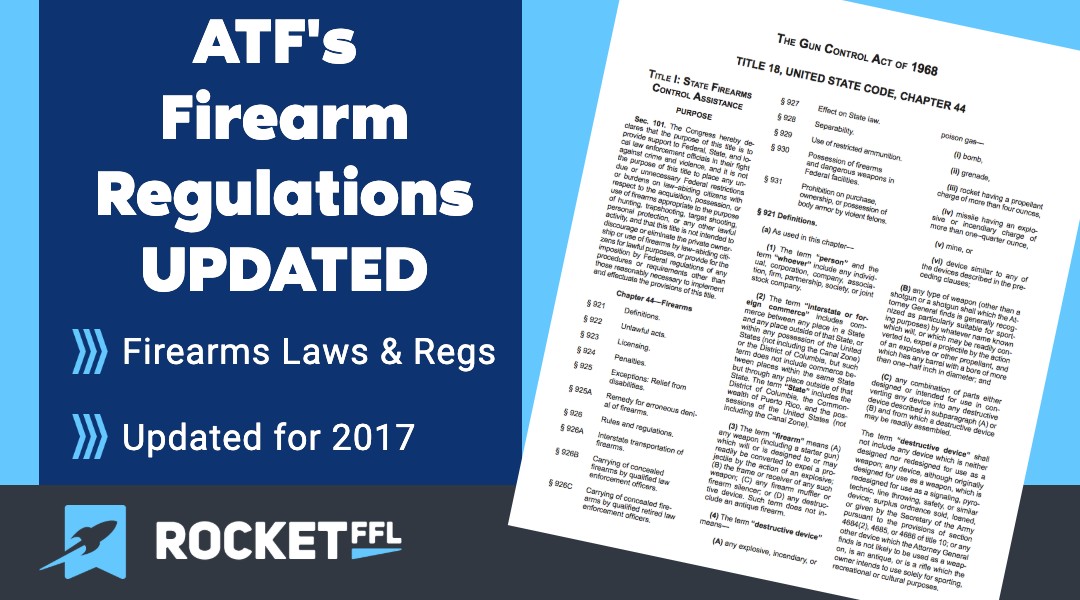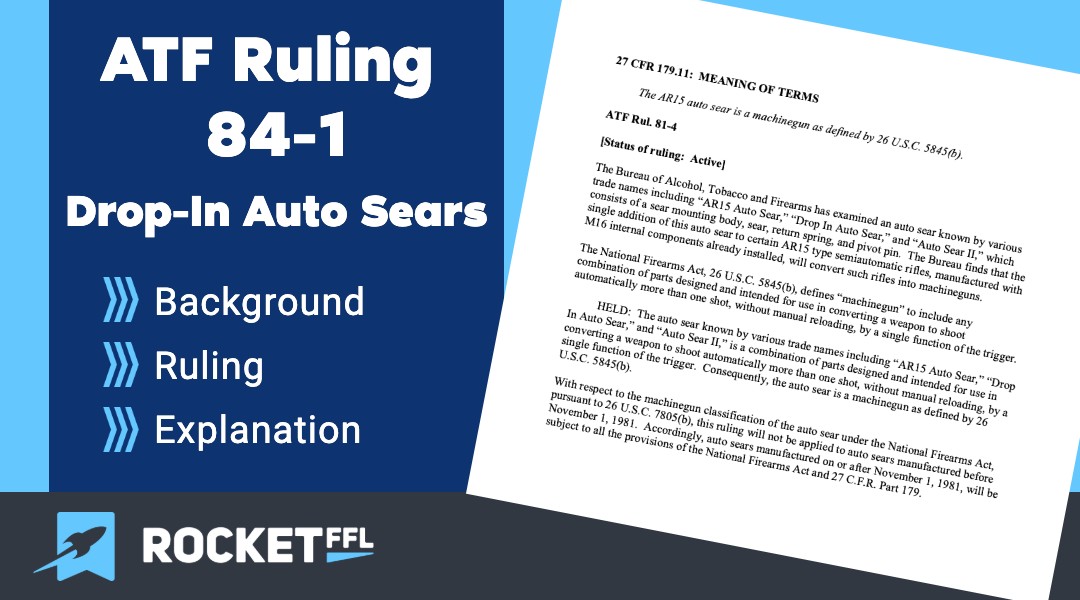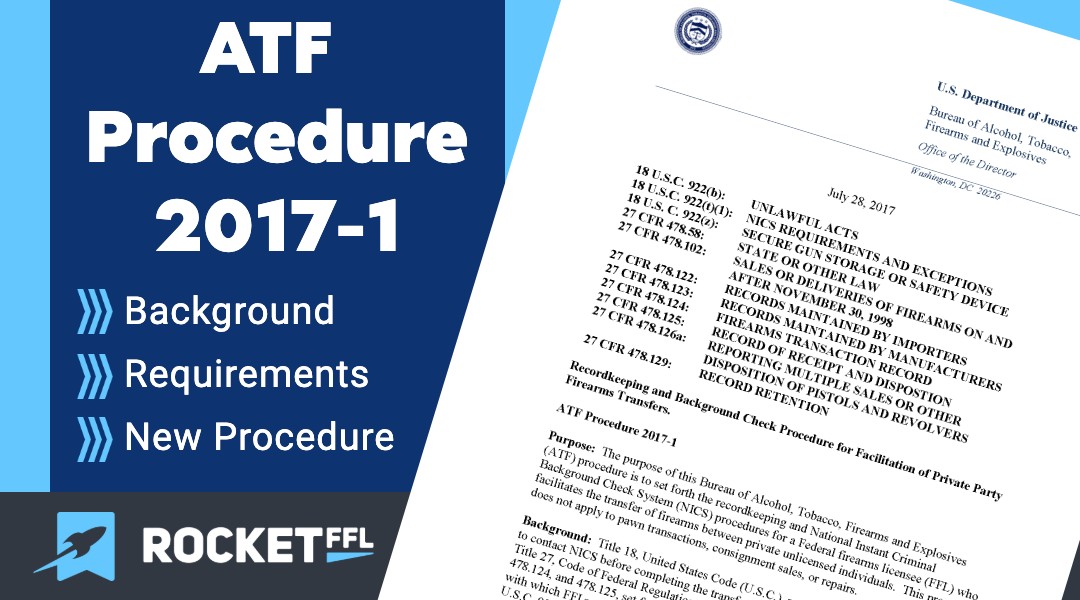The ATF’s Federal Firearm Regulations Reference Guide (FFRRG) has been updated for 2023! The ATF hasn’t updated the FFRRG since 2014 and if you want to order the outdated copy from the federal government, it’ll cost you $39.95. RocketFFL, the leader in helping you get your FFL and stay compliant and in business once you’ve […]
ATF Ruling 2016-5
ATF Ruling 2016-5:
18 U.S.C. 845: EXCEPTIONS
18 U.S.C. 921: DESTRUCTIVE DEVICE DEFINITION
18 U.S.C. 923: IDENTIFICATION OF FIREARMS
26 U.S.C. 5842: IDENTIFICATION OF FIREARMS
26 U.S.C. 5845: DESTRUCTIVE DEVICE DEFINITION
27 CFR 478.22: ALTERNATE METHODS OR PROCEDURES
27 CFR 478.92: FIREARMS IDENTIFICATION
27 CFR 479.26: ALTERNATE METHODS OR PROCEDURES
27 CFR 479.102: FIREARMS IDENTIFICATION
27 CFR 555.109: IDENTIFICATION OF EXPLOSIVE MATERIALS 27 CFR 555.141: EXEMPTIONS
The Bureau of Alcohol, Tobacco, Firearms and Explosives (ATF) authorizes an alternate method or procedure to the firearms marking requirements contained in title 27, Code of Federal Regulations (CFR), sections 478.92 and 479.102. Specifically, ATF authorizes licensed manufacturers of certain destructive device munitions that are manufactured for and transferred to the U.S. Government (USG) to mark these destructive device munitions with sequential lot numbers, provided conditions set forth in this ruling are met.
ATF Rul. 2016-5
Federal firearms licensees (FFLs), licensed under the Gun Control Act of 1968 (GCA) as manufacturers (type-10) and who pay a special occupational tax (unless exempt) under the National Firearms Act (NFA), are permitted to manufacture destructive devices under Federal law. These destructive devices are usually sold to the USG and include destructive device munitions such as explosive or incendiary bombs, grenades, mines and other explosive, incendiary or poison gas weapons as defined in the GCA, 18 U.S.C. 921(a)(4)(A), and the NFA, 26 U.S.C. 5845(f)(1). Type 10 FFLs have recently inquired about marking variances for these destructive device munitions manufactured as part of a valid USG contract. The FFLs point out that government contracts require specific markings, and that these markings may conflict with those required by the GCA and NFA. Further, FFLs note that applying for and awaiting approval of variances creates difficulties in fulfilling contracts in a timely manner.Destructive devices are “firearms” under the GCA and NFA and, therefore, must be marked in accordance with each statute. The GCA provides, in part, that licensed manufacturers “shall identify, by means of a serial number engraved or cast on the receiver or frame of the weapon, in such manner as the Attorney General shall by regulations prescribe, each firearm imported or manufactured by such importer or manufacturer.” 18 U.S.C. 923(i). Similarly, the NFA requires that firearms “classified as a destructive device shall be identified in such manner” as the regulations prescribe. 26 U.S.C. 5842.
The GCA regulation at 27 CFR 478.92 requires a licensed manufacturer to identify firearms by engraving, casting, stamping (impressing), or otherwise conspicuously placing or causing to be engraved, cast, stamped (impressed) or placed on the frame or receiver thereof an individual serial number and other identifying information. Specifically, the regulation requires that for firearms manufactured or imported on and after January 30, 2002, the engraving, casting, or stamping (impressing) of the serial number must be to a minimum depth of .003 inch and in a print size no smaller than 1⁄16 inch. The same requirements appear in the regulations implementing the NFA. See 27 CFR 479.102. Further, “in the case of a destructive device, the Director may authorize other means of identifying that weapon upon receipt of a letter application…showing that engraving, casting or stamping (impressing) such a weapon would be dangerous or impracticable.” 27 CFR 478.92 and 479.102. In each case, ATF may permit an alternate means of marking the destructive device munitions.
Similarly, the regulations implementing marking requirements under the Federal explosives laws, 27 CFR 555.109, require that explosive materials, whether manufactured in the United States or imported, must contain certain marks of identification. Licensed manufacturers who manufacture explosive materials for sale or distribution must place certain markings on explosive materials at the time of manufacture, including the name of the manufacturer and the location, date, and shift of manufacture, if applicable. However, the law at 18 U.S.C. § 845(a)(6) and the implementing regulation at 27 CFR § 555.141(a)(5) exempt explosive materials manufactured on behalf of the USG. Therefore, explosive munitions, which include some destructive device munitions, manufactured under a U.S. Department of Defense (DOD) contract or other USG contract are exempt from the marking requirements at 27 CFR § 555.109. In these cases, manufacturers need not apply for, and ATF need not approve, a marking variance for the explosive munitions.
Pursuant to sections 478.92 and 479.102, the ATF Director may approve an alternate means of identifying destructive devices if the manufacturer shows that the prescribed methods would be dangerous or impracticable. In addition, the regulations at 27 CFR 478.22 and 479.26, provide that the ATF Director may approve an alternate method or procedure in lieu of a method or procedure specifically prescribed in the regulations when he or she finds that: (1) good cause is shown for the use of the alternate method or procedure; (2) the alternate method or procedure is within the purpose of, and consistent with the effect intended by, the specifically prescribed method or procedure and that the alternate method or procedure is substantially equivalent to that specifically prescribed method or procedure; and (3) the alternate method or procedure will not be contrary to any provision of law and will not result in an increase in cost to the Government or hinder the effective administration of 27 CFR part 478 or 479.ATF recognizes that the current process to request a marking variance for destructive device munitions can be time consuming to both the industry and to ATF. ATF also understands that the nature of defense contracting, including USG marking requirements for government firearms and ammunition, compounds the difficulties. Implementation of an alternate method for marking destructive devices will solve many of the difficulties posed by this process, will lower administrative costs, and will not have a negative impact on public safety or security.
Therefore, ATF finds that marking destructive devices defined in 18 U.S.C. 921(a)(4)(A) and 27 U.S.C. 5845(f)(1) is impracticable under USG contracts and there is good cause to authorize a variance from the marking requirements for these destructive device munitions when FFLs manufacture destructive device munitions for the USG. ATF also finds that, provided certain conditions are met, the alternate method set forth in this ruling is reasonable and is within the purpose of and consistent with the provisions of 27 CFR 478.92 and 479.102. Further, this alternate method is not contrary to any provision of law, will not increase costs to ATF, and will not hinder the effective administration of the regulations.
Held, ATF authorizes an alternate method or procedure to the marking requirements of 27 CFR 478.92 and 479.102, pursuant to the authority in those sections, and in 27 CFR 478.22 and 479.26. Specifically, ATF authorizes licensed manufacturers of certain destructive device munitions for the USG to mark these destructive device munitions with sequential lot numbers, provided all of the following conditions are met:
1. The certain destructive device munitions include only explosive, incendiary, or poison gas, bombs, grenades, rockets having a propellant charge of more than 4 ounces, missiles having an explosive or incendiary charge of more than one-quarter ounce, or mines.
2. The destructive device munitions are being manufactured to fulfill a current USG contract.
3. The licensed manufacturer is currently a party to that existing USG contract.
4. The alternate markings comply with the requirements of the existing USG contract including:
a. Lot number sequences comply with MIL-STD-130 (marking and identification of government property) and MIL-STD-1168C; and
b. lot numbers are comprised of only Roman letters and Arabic numerals, or solely Arabic numerals (cannot contain special characters other than a hyphen); and
c. only one lot number is used for each production run unless the contract specifies
otherwise.
5. The markings shall be:
a. Applied with permanent ink or paint utilizing stenciling and/or stamping techniques per current USG or DOD standard; and
4
b. placed on labels that are permanently affixed when labels are utilized.
6. If the destructive device is enclosed/covered by a container, the outermost container must be marked as set out above.
7. Prior to engaging in the manufacturing process, the licensed manufacturer must submit to ATF the manufacturer’s name, address, and license number; the contract number of the existing USG contract under which the destructive device munitions will be manufactured; and the sequential lot numbers that will be used for the destructive device munitions manufactured under the USG contract.
8. The licensed manufacturer must maintain copies of its submission to ATF of the information required by this ruling with its permanent records of manufacture. The licensed manufacturer must retain proof of its submission to ATF (e.g., certified return receipt mail or tracking number). This proof of submission should show that it was sent to ATF’s National Tracing Center, or any other office that ATF may designate as the proper recipient of such information. Additionally, the manufacturer must allow ATF representatives to inspect such documents upon request at any time during business hours without a warrant.
Held further, if all conditions in this ruling are met, licensed manufacturers are not
required to submit marking variances to alternately mark said destructive device munitions that are intended for the USG.
Held further, if the licensee fails to abide by the conditions of this ruling, uses any procedure that hinders the effective administration of the Federal firearms laws or regulations, or any legal or administrative difficulties arise due to the use of the alternate marking procedures outlined in this ruling, the licensee is no longer authorized to mark firearms as permitted by this ruling.
This ruling applies only to those destructive device munitions that are produced under contract with and transferred to the agency listed on the USG contract.
Licensees are reminded of their responsibility to ensure accuracy and completeness of all required records when utilizing this alternate method. Manufacturers still must abide by all other provisions relating to the manufacture, transfer, and possession of NFA firearms and explosives.
Recommended Posts



